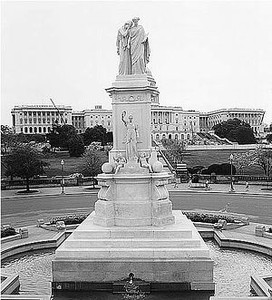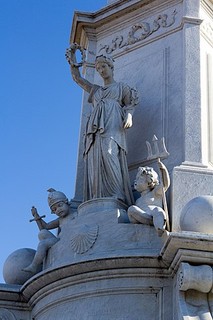Peace Monument
Introduction
Text-to-speech Audio
Dedicated in 1877, the Peace Monument stands in remembrance of members of the United States Navy who perished in battle in defense of the Union during the Civil War. The Monument is also known as the Naval Monument and the Civil War Sailors Monument. The monument is over 40 feet tall and is one of several large monuments in the nation. It also stands as apart of a trifecta of sculptures next to the James A. Garfield Monument and the Ulysses S. Grant Memorial.
Images
The Peace Monument stands with the Capital Building as a backdrop. Picture by an unknown employee of the the federal government and all images are located in public domain.

The Peace Monument was one of several monuments envisioned by veterans and military leaders as the Civil War came to a close. It was dedicated in 1878.

Backstory and Context
Text-to-speech Audio
The United States Navy were adamant in protecting the Union Army during the American Civil War which led to this monument being dedicated to their work. The original idea for the monument was conceived by Admiral David Dixon Porter, who was the commander of a fleet of boats during the Civil War. Porter made the first design for the statue and spent time raising money to erect the monument from private donors. He had a simpler idea for the statue in 1865 that only involved two figures. This idea would eventually evolve into what viewers see today in a complex monument with several figures and objects of meaning. On a stylus attached to the monument, it reads:
“They died that their country might live.”
The monument is a neoclassical Civil War monument designed and created by sculptor Frank Simmons. Simmons was born in Maine and was known for his portrait busts. Simmons sculpted the Peace Monument as well as several other pieces for display at the United States Capitol. The first thing a visitor of the monument will notice is the unique location of the monument as it sits inside Peace Circle surrounded by water. A visitor will also observe how the monument towers from above are standing at 44 feet tall. The monument is made out of marble from Carrera, Italy where it was sculpted by Simmons. Once finished and shipped to the United States, the monument was placed on a base of Maine blue granite.
The top of the monument has two robed women. One of the woman (Grief) holds her head on the other’s (History) shoulder while weeping in mourning. History holds a tablet that has the previous quote mentioned above attached onto it. Below Grief and History is another figure of a woman who holds a laurel wreath high and an oak branch as symbols of strength. This figure is named Victory. Further down on the monument, visitors will see the figures of infant Neptune and infant Mars. Infant Mars is the God of War while infant Neptune is the God of Sea. On the opposite side, another figure of a woman stands only covered from the waist down holding a olive sprig. This woman is named Peace. The monument has several other symbols of peace and industry to include a sickle resting across a sword and a dove that is since missing nesting on a sheaf of wheat. Symbols of literature, science, and art also appear on the statue in the shapes of a book, gear, angle, and pair of dividers.
Cite This Entry
Admin, Clio, Matthew Siebel, and Jonathan Still on behalf of Clio Volunteer Editors. "Peace Monument." Clio: Your Guide to History. July 26, 2021. Accessed July 26, 2025. https://theclio.com/entry/46229
Sources
The Peace Monument. Architect of the Capital. Accessed September 21, 2017. https://www.aoc.gov/capitol-grounds/peace-monument.
Picture By Jamieadams99 at English Wikipedia, CC BY-SA 3.0, https://commons.wikimedia.org/w/index.php?curid=62309129
Inventory of American Sculpture. Smithsonian American Art Museum. Control number 77006655

